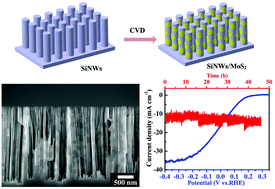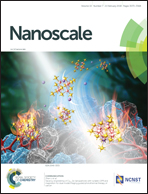One-step chemical vapor deposition of MoS2 nanosheets on SiNWs as photocathodes for efficient and stable solar-driven hydrogen production†
Abstract
Silicon nanowires (SiNWs) are widely used as photocathodes because of their large electrochemically available surface-area density and inherent ability to decouple light absorption from the transport of minority carriers. In order to minimize overpotential for solar-driven hydrogen (H2) production, a combination of an ultrathin molybdenum disulfide (MoS2) layer with SiNWs as photocathode has attracted much attention. Herein, for the first time, this study presents the synthesis of a composite photocathode via direct growth of ultrathin MoS2 nanosheets on SiNWs (referred to as SiNWs/MoS2) by one-step chemical vapor deposition (CVD). Due to the high surface-area density of the arrays of SiNWs, the discontinuous MoS2 nanosheets grown on the SiNWs achieved a much higher density of active sites. Moreover, the coating of MoS2 on the SiNWs was found to protect the photocathode during the photoelectrochemical (PEC) reaction. A high efficiency with photocurrent jsc of 16.5 mA cm−2 (at 0 V vs. reversible hydrogen electrode) and an excellent stability over 48 h of PEC operation were achieved under a simulated 1 sun irradiation.



 Please wait while we load your content...
Please wait while we load your content...